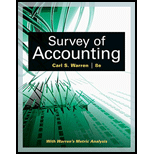
Issuing stock
Sahara Unlimited Inc. began operations on January 2,20Y4. with the issuance of 250.000 shares of $8 par common stock. The sole stockholders of Sahara Unlimited Inc. are Karina Takemoto and Dr. Noah Grove, who organized Sahara Unlimited Inc. with the objective of developing a new flu vaccine. Dr. Grove claims that the flu vaccine, which is nearing the final development stage, will protect individuals against 80% of the flu types mat have been medically identified. To complete me project, Sahara Unlimited Inc. needs $25,000,000 of additional funds. The banks have been unwilling to loan the funds because of the lack of sufficient collateral and the riskiness of the business. The following is a conversation between Karina Takemoto, the chief executive officer of Sahara Unlimited Inc., and Dr. Noah Grove, the leading researcher:
Karina: What are we going to do? The hanks won't loan us any more money, and we've got to have $25 million to complete the project. We are so close! It would be a disaster to quit now. The only thing I can think of is to issue additional stock. Do you have any suggestions?
Noah: I guess you're right. But if the banks won't loan us any more money, how do you think we can find any investors to buy stock?
Karina: I've been thinking about that. What if we promise the investors that we will pay them 2% of sales until they have received an amount equal to what they paid for the stock?
Noah: What happens when we pay back the $25 million? Do the investors get to keep the Stock? If they do, it'll dilute our ownership.
Karina: How about, if after we pay back the $25 million, we make them turn in their stock for what they paid for it? Plus, we could pay them an additional $50 per share. Thai's a $50 profit per share for the investors.
Noab: It could work. We gel our money, but don't have to pay any interest or dividends until we start generating sales. At the same time, the investors could get their money back plus $50 per share.
Karina: We'll need current financial statements for the new investors. I'll get our accountant working on them and contact our attorney to draw up a legally binding contract for the new investors. Yes, this could work.
In late 20Y4, the attorney and the various regulatory authorities approved the new stock offering, and shares of common stock were privately sold to new investors for $25,000,000.
In preparing financial statements for 20Y4, Karina Takemoto and Glenn Bergum, the controller for Sahara Unlimited Inc., have the following conversation:
Glenn: Karina, I've got a problem.
Karina: What's that, Glenn?
Glenn: Issuing common stock to raise that additional $25 million was a great idea. But ...
Karina: But what?
Glenn: I've got to prepare the 20Y4 annual financial statements, and I am not sure how to classify the common stock.
Karina: What do you mean? It's common stock.
Glenn: I'm not so sure. I called the auditor and explained how we are contractually obligated to pay the new stockholders 2% of sales until they receive what they paid for the stock. Then. we may be obligated to pay them $50 per share.
Karina: So ...
Glenn: So the auditor thinks that we should classify the additional issuance of $25 million as debt, not stock! And, if we put the $25 million on the balance sheet as debt, we will violate our other loan agreements with the banks. And, if these agreements are violated- the banks may call in all our debt immediately. If they do that, we are in deep trouble. We'll probably have to file for bankruptcy. We just don't have the cash to pay off the banks.
What do you ihink might be a practical solution to this classification problem?
Want to see the full answer?
Check out a sample textbook solution
Chapter 8 Solutions
Survey of Accounting (Accounting I)
- I am looking for help with this general accounting question using proper accounting standards.arrow_forwardI am trying to find the accurate solution to this general accounting problem with the correct explanation.arrow_forwardPlease provide the answer to this general accounting question with proper steps.arrow_forward
 Financial AccountingAccountingISBN:9781305088436Author:Carl Warren, Jim Reeve, Jonathan DuchacPublisher:Cengage Learning
Financial AccountingAccountingISBN:9781305088436Author:Carl Warren, Jim Reeve, Jonathan DuchacPublisher:Cengage Learning Financial AccountingAccountingISBN:9781337272124Author:Carl Warren, James M. Reeve, Jonathan DuchacPublisher:Cengage Learning
Financial AccountingAccountingISBN:9781337272124Author:Carl Warren, James M. Reeve, Jonathan DuchacPublisher:Cengage Learning Survey of Accounting (Accounting I)AccountingISBN:9781305961883Author:Carl WarrenPublisher:Cengage Learning
Survey of Accounting (Accounting I)AccountingISBN:9781305961883Author:Carl WarrenPublisher:Cengage Learning


